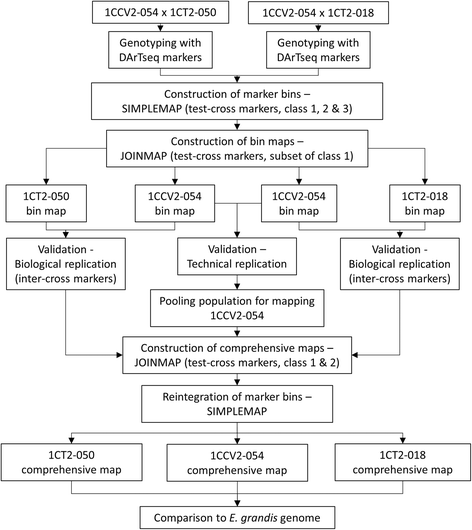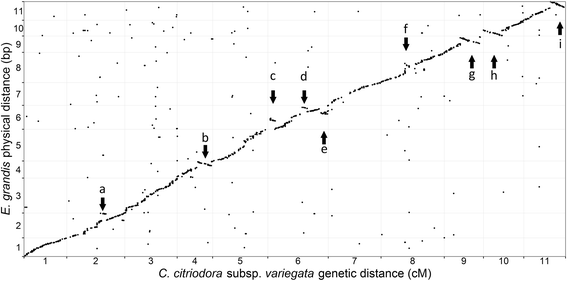Comparative genomics of Eucalyptus and Corymbia reveals low rates of genome structural rearrangement
- PMID: 28532390
- PMCID: PMC5441008
- DOI: 10.1186/s12864-017-3782-7
Comparative genomics of Eucalyptus and Corymbia reveals low rates of genome structural rearrangement
Abstract
Background: Previous studies suggest genome structure is largely conserved between Eucalyptus species. However, it is unknown if this conservation extends to more divergent eucalypt taxa. We performed comparative genomics between the eucalypt genera Eucalyptus and Corymbia. Our results will facilitate transfer of genomic information between these important taxa and provide further insights into the rate of structural change in tree genomes.
Results: We constructed three high density linkage maps for two Corymbia species (Corymbia citriodora subsp. variegata and Corymbia torelliana) which were used to compare genome structure between both species and Eucalyptus grandis. Genome structure was highly conserved between the Corymbia species. However, the comparison of Corymbia and E. grandis suggests large (from 1-13 MB) intra-chromosomal rearrangements have occurred on seven of the 11 chromosomes. Most rearrangements were supported through comparisons of the three independent Corymbia maps to the E. grandis genome sequence, and to other independently constructed Eucalyptus linkage maps.
Conclusions: These are the first large scale chromosomal rearrangements discovered between eucalypts. Nonetheless, in the general context of plants, the genomic structure of the two genera was remarkably conserved; adding to a growing body of evidence that conservation of genome structure is common amongst woody angiosperms.
Keywords: Chromosome rearrangement; Corymbia citriodora; DArTseq; Eucalyptus grandis; Genome structure; Linkage mapping.
Figures



References
-
- Arabidopsis Genome Initiative. Analysis of the genome sequence of the flowering plant Arabidopsis thaliana. Nature. 2000;408(6814):796–815. - PubMed
Publication types
MeSH terms
LinkOut - more resources
Full Text Sources
Other Literature Sources
Miscellaneous

